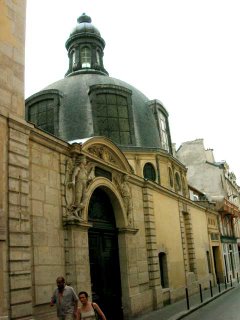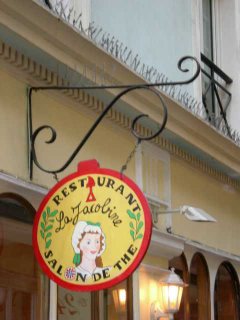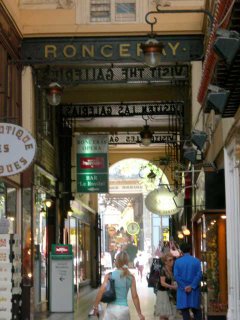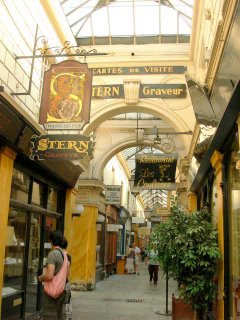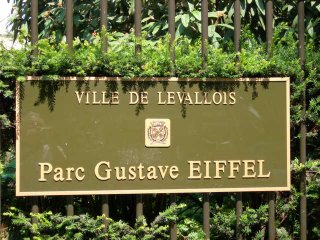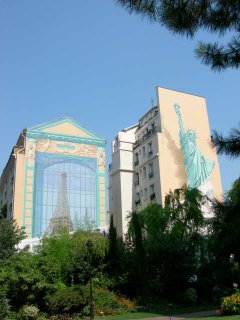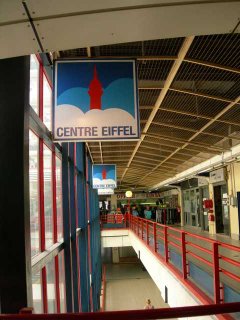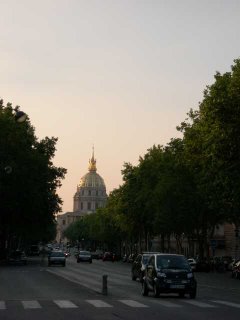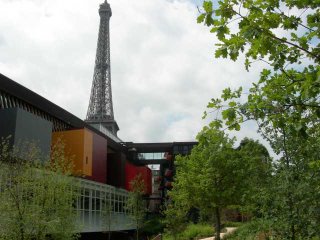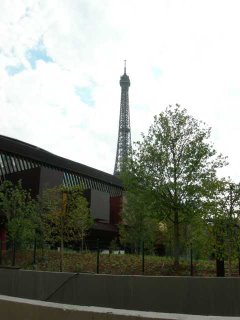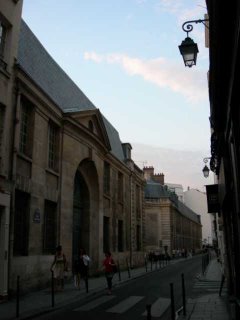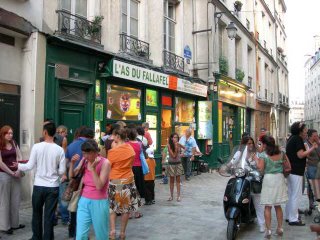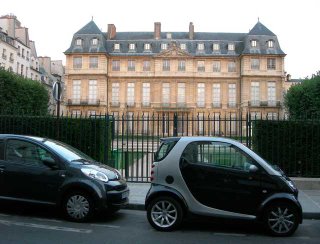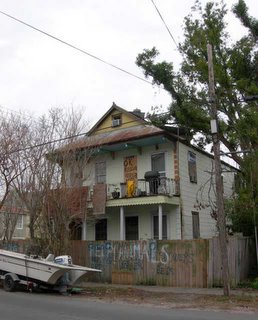sábado, agosto 26, 2006
A year ago, the Saturday morning of freshman orientation, I was doing my radio show and Katrina was in the gulf. It was hard to get through the huge traffic jam when I drove to the on-campus radio station - parents and kids unloading SUV's. In the middle of my show (I have completely forgotten the opera I played), I learned that Tulane's president was to make an announcement at noon. When I left the studio, parents and students were reloading the SUV's - Tulane was closing down and everybody was sent home.
The following morning at 6:30, my level-headed friend Janie and I piled into her car and headed out of town. I took newly adopted Gris-Gris with me and left plenty of food and water for Felix and Rocco - expecting to be back in town in no more than 3 days. We headed north and found ourselves in Tunica, Mississippi - just south of Memphis - where my brother Gary arranged accommodations in one of the casinos owned by his company MGM-Mirage.
Two confusing and stressful weeks later, after sneaking back into New Orleans with Janie from our safe haven in La Place, Louisiana at the home of Tommy and Jerrie St. Martin, I was able to rescue Felix and Rocco (who had been fed by Elliot Barron). I retrieved my car, assessed the damage - typical burglary plus broken back door, scrubbed down the refrigerator - (remind me not to buy frozen guacamole.) At this point, Janie and I went our separate ways - she to a friends houe in Albuquerque and me to Austin. I don't know how I would have survived those first difficult weeks without her humor, support and constructive thinking. My little household reunited, we headed to Austin where Clint Bledsoe, a friend who had been a Latin American Studies student some years ago, had arranged for me to sub-let his sister's apartment. And the very happy (if you discount an Achilles tendon rupture and repair) Austin chapter of my life began.
There are so many people to thank for making my exile as much of an enjoyable adventure as it was. The acts of kindness from strangers cannot be counted - from institutions (the attention Gris-Gris received at the Austin Humane Society to my own adoption by the University of Texas) and those who make such superb institutions possible - Professors América Rodriguéz and Nicolas Shumway. And then so much good will, help and great companionship by friends old and new: the noble and aforementioned Clint Bledsoe (who took me to every single doctor's appointment), Gary Greenblum, Jarrod Beck (who drove us back to New Orleans - my foot was still in its cast), Whitney Zoller Hyde, Pepe Pierce and my cousin Tess Amsel (who I hadn't seen since I summed in the Laurentians as a kid.)
While I am looking forward to a normal, almost uneventful year, it is reassuring to know that under the most difficult of circumstances, there is a larger community which will, in the words of the gospel song I used to sing with Shades of Praise, "Lift you up" in times of need. Thank you all, from the bottom of my heart.
martes, agosto 22, 2006

St. Thomas Church, Strasbourg
Today, I requested a proficiency exam in French and drove through my old Broadmoor neighborhood. It was severely affected by Katrina. This is a quite fancy area, not too far from Tulane and Uptown, areas that primarily suffered wind damage and are referred to as part of the "Isle of Denial." Here, there are signs of recovery. Some houses seem to be receiving attention. SUV's are parked in driveways, contractor's trucks along the street. There are many "For Sale" signs, stripped or neglected yards but it appears, that at least here, it seems likely that the neighborhood will recover. I have yet to venture back to the neighborhoods close to Lake Ponchartrain or down-river of the Industrial Canal - areas with much less secure futures.
We are approaching the anniversary of Katrina and there have been articles in magazines that I am finally receiving again - the New Yorker, the New Republic. There was a traditional Jazz Funeral, last weekend, for the pets that were lost to Katrina. The city seems caught up in a great mood of depression. People coming back to the city, even after a time short away, are struck by the slow pace of recovery. It seems like the time to make a more realistic assessment of futures here. I see two time frames. In the next five years, I predict the city will condense. The residents of many of the flooded neighborhoods will realize that reconstruction will not be happening at an acceptable pace and that, in the end, it is unwise to reconstruct their houses. The resulting scattering of restored houses within the block after block of abandonment, despite the effort and investment will only produce an unlivable and dangerous situation. Government policy, could have avoided what I believe will be a second wave of ex-migration by concentrating reconstruction and avoiding the discouragement of dispersion but politics, or the lack of courageous communication, would not generate support for decisive public action.
On January 12, 2006, I wrote about the Hotel Isle of Dry a neighbor's house that was surrounded by a wooden fence covered with blue spray paint graffiti. A friend, a nearby shop owner, provided this update. The owner of the house very likely did not evacuate and stayed in his property during the period after the storm and before the city was forcibly evacuated. Apparently, bands of looters swept the neighborhood. They broke into my house, as well. The owner of the Hotel Isle of Dry was armed and was aggressively defending his house and block. A rumor spread that the gang of looters was after him. At that point, he grabbed a spray gun and attempted to give the impression that police and rescuers were now staying in his house. On the other hand, this too could be an urban legend.
Check out my Strasbourg photos:
http://pg.photos.yahoo.com/ph/spjacobs70118/album?.dir=/9289re2&.src=ph&.tok=ph4mlYFBWZgJBjoW
martes, agosto 08, 2006
Where are the charming travelers who, in years past, would share my little 6-passenger 1st Class compartment? Not on this leg of the journey. No-one to share greasy dried sausage or tales of misfortune during the last stopover. I speed through the landscape of eastern France following the German border. The last station was Belfort. I had spent a night or two there in the ‘60s when I visited Le Corbusier’s Ronchap, in a nearby village.
I’m surprised by the amount of corn that grows in fields along the tracks – not only here but between Avignon and Dijon. I was surprised to learn that mustard seed is no longer grown in France but is imported from Saskatchewan – it is far too valuable to use the land to grow grapes. Yesterday’s visit to the Mustard Museum (in the Amora plant) taught me at least that. It appears, although it was certainly not stressed, that the basic mustard mix which is elaborated to produce the famous Maille brand (for 20 years merged with the more mass-market Amora brand) gets shipped out to another factory in the outskirts of Dijon while the Amora mix receives a bit more fine tuning and is bottled right there. The Maille factory takes the same basic mix and adds it's own blend of spices and other flavorings.
The train follows a series of canals. Their locks appear to be miniature versions of the ones I passed through in Panama a few years ago. The train from Paris to Sète was a TGV. In the snack bar, they displayed the current speed. Two little boys cheered when we moved faster than 240 km / hr and booed when we slowed down. My current train is the old-fashioned sort and unlike the split-level TGVs (where First Class was on the lower level and you saw little of the landscape), I am enjoying the landscape speed by. Strasbourg in an hour.
lunes, agosto 07, 2006
Last night I had the most agreeable and delicious (unaccompanied) dinner I’ve had so far. After a day of conscientious art and wine tourism in Beaune, I returned to Dijon and discovered the Place Emile Zola. Perfectly scaled – a bit broader than the three-story height of its buildings, it was full of tables from the many surrounding restaurants. A scattering of plane trees – called plantain’s in French – the chattering of animated conversations and the scurrying of waiters – all were bathed in that beautiful extended twilight that I have grown so used to. I selected a place – Les Moules Zola – and ordered moules marinières, frites and a carafe of white wine. Absolutely perfect.
That morning, I took the train to Beaune. The railroad station was a moderate hike from the center that was – I won’t say crawling – dense with tourists and attendant services. The big attraction from an artistic point of view is the Hôtel-Dieu or Hospices. A local nobleman, concerned about disease and poverty following the 100 Years War, built it in the Mid-15th Century. The main space – a huge barn-like room with carved and painted trusses – had two rows of Pullman-like curtained beds along both long walls. They were separated by the walls by aisles permitting the patients to be attended to by nurses (nuns) without impeding their view of an altar at one end of the space. The altarpiece – a magnificent polyptic painted by Roger van der Weyden – of the Last Judgment is now housed in a climate-controlled space across the courtyard. Ordinarily, the patients would view the exterior panels – monochrome representations of saints and donors. Once a week, a High Mass would be celebrated and the full glory of the richly colored and gilded painting of enthroned Jesus and an angel weighing the fate of a parade of nude mortals would be revealed. I imagine for the infirm, one viewing a week would be more than enough.
Once, I paid my respects to Western cultural heritage, I crossed the street to the Marché aux Vins. Twenty years ago, when I taught a summer course for the School of Architecture, I brought my students to Beaune and we followed a visit to the Hospice with a dégustation here. In those days, there were 35 wines to sample, yesterday a mere 15. By the time we entered the “chapel,� the final space with its high ceilings and the best and most expensive wines, we were already soused. This time, there was a time limit and an injunction to only sample a wine once. I joined a Japanese visitor and eventually a group of Belgians – they seem omnipresent. We were given score sheets and I tried to be as objective as I could – the Mersault and the, believe it or not, Nuits-Saint-Georges were my favorites.
domingo, agosto 06, 2006
Tomorrow, I will visit the lovely small city Beaune, at the other end of the Côte d’Or wine region. But today, I went to the town of Nuit-Saint-Georges. It was chilly and overcast and I was reminded again why I had lugged my jacket through the airports and Paris metro to the South of France. The town itself is a charming place with a little square with a recently built, but traditionally quirky, town hall at one end and a scattering of open-air cafés in the middle. There are, no doubt, townsfolk who work in the vineyards and estates but everything seemed geared to welcome and impress tourists like me.
I went to the cave that was part of my $15 euro package and the fellow at the counter did not know anything about it and the visit was free anyhow. I sampled some lovely white wine from their Pouligny-Montrachet production. This wine has a particular significance to me. More years ago than I want to compute, Dennis Diego and I formed a partnership – Diego-Jacobs Design Associates. To celebrate its formation, we had a celebratory dinner at Le Ruth’s – one of the best restaurants in New Orleans in those years - and ordered a bottle of that famous white wine – delectable then and certainly delicious this afternoon – though limited to a few tiny sips. A "degustation" is a sampling, after all.
Later on, I visited the Cassissium (one of the places my package included – here they did ordinarily charge a $6.50 euro admission). It was, presumably, a museum devoted to the production of Cassis – a liquor made from black currents. I was disappointed (I wonder why) to find out that the sweetness and the alcohol are added to a concentrated extract of the berries and not a product of the process of their own fermentation. Many years ago, I attempted to make Kahlua and the process was identical – alcohol, honey and vanilla extract were added to a concentrated (Toddy) extract of coffee. My results were horrible and even the best vanilla ice-cream couldn’t disguise the strange off taste. I suppose, if I was careful, took notes and adjusted the recipe but, for $14 a bottle, why bother. Of course, these tours and degustations are ploys to encourage visitors to fill their cars and cellars with cases of wine and liquors – even the supposed Cassis museum was really an extension of a producer.
The very pretty and efficient guide was charming (how do so many people talk and smile at the same time?). She took us through the Cassis plant, explained the process and eventually poured the tasty thick samples. There were a few children in the group – one little boy was a redhead with very close-cropped hair such that his own skin tone glowed through and his head seemed radiant. They were offered soda water with the flavored syrups of their choice. Then we were offered kir – cassis and white wine from a tap. I was the only English speaker in the group - mainly French and German. As a matter of fact, I haven’t seen any North Americans since I left Paris.
I’m back in Dijon and will treat myself to a nice dinner and some good wine. Last night’s Boeuf Borguinon was quite good. I bet it wouldn’t be too difficult to prepare at home.
jueves, agosto 03, 2006
I've just had a tasty Thai lunch in a shady little square next to a gothic church in this walled city. The breeze sturrst the leaves of two plain trees, making me feel even cooler. I'm not at all ambitious about visiting the various museums and galleries. I haven't seen a laundromat, but if I do - laundry and a good read would just hit the spot.
I'm happy to be anoe after 2 days of intense interaction. The light is so bright and crisp today, ideal for photography. The creamy yellow of the local stone, the sharp contours and the twisting irregularities of the streets produce one picturesque prospect after the other.
Tomorrow, I return to Dijon.
Reunion by the Sea
On Sunday, I said goodbye to my Paris studio apartment and caught the TGV (Train de Gran Vitesse) for Sète on the Mediterranean. Gran Vitesse – yes, when it finally gets rolling. About a half hour outside of Paris, the train headed back to the station. There was an electrical problem and we scrambled aboard an identical train on the next track – in a scene straight out of Jacques TatÃ. Finally, the French landscape zipped by. In only 3-1/2 hours, I arrived in Séte, a small coastal city on a peninsula to the west of Montpellier. Catherine and Yves Lepere were waiting for me and took me to my hotel.
Days of short trips to nearby villages, breezy dinners on their terrace overlooking the sea accompanied long talks about our shared experiences over some forty years of friendship and reflections about our own lives. Yves and Catherine have just retired from teaching in Belgian universities. Their retirements were mandatory. When you reach 65, that’s it. Yves will still give lectures and short courses in architecture schools all over Belgium but, for Catherine it is an abrupt end to a long career of teaching philosophy and psychology courses for architecture students. For her, retirement came far to soon. Meanwhile, they have sold their house and Yves’s studio – both contained in a farmhouse at the edge of a small rural village. Belgium a small country and French-speaking Belgium (Wallonie) is even smaller so commutes to their schools were not extreme.
They are a marvelous couple. They are really opposites: Yves, the man of vision and poetry but with pragmatic underpinnings, Catherine, the passionate intellectual but also the organized businesswoman and manager. In some ways, their partnership reminds me of my own parents marriage of contrasts – possibly further reinforced by their retirement and Sète itself, surprisingly reminiscent of Orange County.
On Tuesday, we had oysters by the bay. It has been warm here too, but unlike Paris, you can wear shorts and loose clothing and there is always a breeze. We ate oysters that tasted of the salt water of Odysseus and the ancients then swam in the Mediterranean .
Yesterday, Yves and Catherine drove me to Avignon by way of Nimes. Avignon is a dense walled city - made even denser by the many tourists. Right now, there is a jazz festival and one of the residents of my hotel is a Flemish pianist who will play this evening. I reserved my seat for Dijon, tomorrow - slowly wending my way back to Paris and New Orleans.Images: http://pg.photos.yahoo.com/ph/spjacobs70118/album?.dir=/4c19re2&.src=ph&.tok=phEYLSFBakmSyZb.
sábado, julio 29, 2006
Fortunately, the temperatures that managed to establish France’s hottest July on record accomplished their goal and Paris has cooled down to its seasonal norm. Strolling around has not been uncomfortable on the shady side of the street. Stuffy museums stay stuffy. The Hôtel de Cluny while it contained exquisite pieces was tomblike, lacking any form of ventilation. They were extraordinarily proud of their Unicorn tapestries but I promise you, the next time you are in New York, visit the Cloisters on the northern tip of Manhattan Island (our Unicorn is better than your Unicorn.)
This afternoon, I visited the Museum of Jewish Art and History, here in the Marais. There were beautiful liturgical pieces, scrolls, candelabra and torahs along with elements of daily life from the Middle Ages – Jews were expelled from France in the 13th Century - and a copy of the declaration giving them full citizenship at the beginning of the 19th Century was on exhibit. But, of course, hovering in the background and in the end, underlying all of the history and the art were the events of the holocaust. I was most affected by the color portraits of contemporary French Jews and their comments about their French-Jewish identity.
I wended my way to the Centre Pompidou, where I discovered they had wireless Internet. I had my laptop with me and sat in relative comfort in the mezzanine café, having purchased a tiny Dixie cup of Hagen Dazs ice cream.
This evening, I took a stroll in my immediate area. I headed into the XI e arrondissement, just across the Boulevard du Temple – my street. I discovered many Asian restaurants including a very pleasant looking Thai place – an eminently suitable place for my final Paris dinner. Paris is far from an exclusively French city. On any simple trip across town or anywhere in between, the number of Africans, Asians and Moslems is striking. As I no doubt wrote, that on the train from the airport, I was so reminded of similar trips in New York, but I think that Paris is far more cosmopolitan. My city is more cosmopolitan than your city.
French television – amazingly similar to our own. I’m watching a fake reality show – survival on a tropical island. But, a few nights ago there was a fantastic competition. Groups, primarily of young people, created theatrical illusions. The strip tease of the invisible man – so cleverly carried out in front of a black curtain. But, the prize winner, and I was totally in agreement, was an apparent ping-pong game in which the players flew into the air to return serves and then gradually the perspective changed and the table and players were seen from above and gradually the perspective returned back to a more usual view. There were at least 11 members of the team, mostly dressed in black, supporting the upper bodies of the players and their fake legs and, of course, lifting and turning the table. How fantastic, a competition which focused on imagination and creativity.
For some reason - blogger is not letting me upload any more photographs - perhaps I have reached my capacity. Here are two recent albums, curtesy of Yahoo:
http://pg.photos.yahoo.com/ph/spjacobs70118/album?.dir=/ffe0re2&.src=ph&.tok=phEHlQFBMphGOyyF
and
http://pg.photos.yahoo.com/ph/spjacobs70118/album?.dir=/83fare2&.src=ph&.tok=phDGlQFBbf.zCnQs
miércoles, julio 26, 2006

Steve in the Archives

Jardins de Luxembourg

Dead Ends
Tomorrow, I plan to visit the Archives of the Ministry of External Affairs. It is dimly possible that they may have some records of the Eiffel and Company’s activities in Peru, Chile and Bolivia. I also have to look at South American history. I believe that when Eiffel was working there in the early 1870s, Arica belonged to Bolivia. Lelièvre, Eiffel’s agent in
Follow-up – the Ministry requires a 2 week prior registration before accessing their archives. I’ll follow that trail some other year. Meanwhile, this morning I tried to locate Eiffel’s factory. As expected, the neighborhood had changed considerably – now full of 1960s apartments. But, I found a park and shopping mall named after the great man, possibly on the site of his factory – street names had changed.
Pavarotti dans le Metro
After dinner, I decided to explore the Left Bank. I took the Metro to Monparnasse and started strolling to the Quartier Latin. I now know where there is a concentration of movie houses (near the Gare Montparnasse), a possible escape on a hot afternoon later on in the week. I wandered down some small streets and found myself at a back entrance of the Jardins de Luxembourg, just as the gendarmes were ushering strollers out – the park closes at sundown. The light was beautiful and I took many more pictures than I have included here.
I needed several changes of Metro lines from Boule-Miche to the Place de la Republique, the stop closest to my apartment. There were several musicians who boarded the trains offering unwelcome performances. But on the final train, I looked up and there was a black curtain strung between two uprights and a Pavarotti puppet started singing La Dame e Mobile from Rigoletto and mopped his brow with a handkerchief – how brilliant!!!
lunes, julio 24, 2006
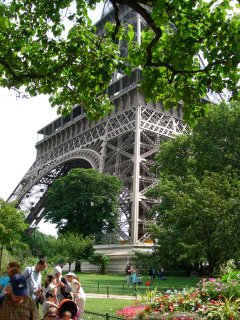

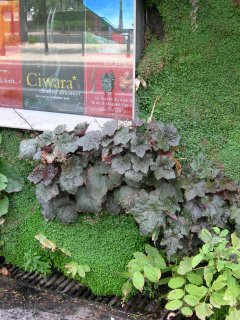
Mes chers amis,
I spent most of the day in the Louvre. The I. M. Pei pyramid and its circulation system manages the crowds very nicely. The distances are enormous and my feet – and everybody else’s – become a focus competing with the paintings. (I was particularly drawn to the big smooth marble and granite feet on Egyptian, Greek and Roman sculptures.) I fell asleep in one of the lower back supporting couches. I’ve been in
Today is the final of the Tour de France. Instead of standing along the Champs-Elysées, I visited the Musée de Quay Branly, near the Tour Eiffel. It just opened and contains a collection of materials from non-Western cultures.
The building, designed by Jean Nouvel (the architect of the monstrous Opera Bastille) is sited along the
After a ¾ hour weight – the attendants promised an hour-and-a-half, perhaps their way of reducing the crowd - I bought my ticket and entered a white volume with a white ramp that passed through a dark passage and I was in the exhibition volume itself. The collection is magnificent and well displayed – although there were some strange amorphous leather-like forms dividing exhibits and guide circulation and which morph into seats with their associated video monitors. An important feature of the façade is a group of volumes projecting out toward the
Actually, the relation between volumes, textures and landscape is quite satisfying and Nouvel displays tremendous resourcefulness in handling forms at this scale. Perhaps, two or three clear organizing elements in the interior of the exhibition space could have supplied a stronger sense of orientation. Once in the exhibition volume, floors continued to slope – I could never figure out to what purpose other than as another distraction. Last night, I walked past the Opera Bastille on my way back from dinner. There, I expect the interiors were very carefully worked out. Here, I feel it’s quite the reverse.
Le Flaneur
I must be crazy or I’m getting used to this
Tomorrow is Saturday and the archives are closed until Monday. I was thinking of a trip to
viernes, julio 21, 2006
Figaro et l’aventure de mes pantalons
This morning I did my laundry.
I accidentally placed my clothes in a machine already occupied.
I left the Laundromat to sit on a shady bench.
When I returned, a frantic Canadian thought that his clothes were stolen.
While waiting for the wash and dry we chatted.
I learned he was staying at the Hotel Beaumarchais
And was departing at noon for Iceland, on his way back home.
When I folded my things, I realized that I had not brought my khakis.
But they were not in the room.
Off to find the Hotel Beaumarchais
And avoid buying new slacks
The receptionist had not heard of any Canadian traveling with his mother
But I decided to wait anyway.
A few minutes later
The Canadian and (certainly not his mother) emerged from the elevator
My pants restored and neatly folded.
Actually, it’s really a rather pleasant place. I go through a not-for-the-public access, around the corner on the Seine side from the main lobby. A staff member takes my passport and gives me an orange badge to wear and I take an elevator up to the 4th floor. After a few false turns, I eventually make my way to a large room with big tables and windows overlooking the Louvre. Fabrice Golec had assembled all the materials I had requested on Tuesday and I started plowing through them.
A few blurry, carbon copy resumées, some handwritten speeches and finally the letters. The problem with Eiffel research is the great man himself. Everything is Eiffel-oriented and one has to look past him to get some kind of a glimpse at the world that surrounded him and, in my case, at the Latin American activities which occurred despite (or because of) Eiffel’s participation.
Through family letters, I have begun to know M. Lelièvre, Eiffel’s agent, an old and faithful member of Eiffel’s company and a dear family friend. I stopped (or was stopped because it was 5 pm) at the point that Lelièvre has arrived with his family in Lima. Tomorrow, I will learn that he died from some tropical disease. One becomes attached to these people – their handwriting, terms of endearment, discussions of wedding arrangements, and business worries. There is something so intimate about reading the actual letters.
It rained last night and the tall windows in my apartment are either open or closed. So, I’m afraid I did let some rain inside – otherwise there would have been even less air. I had lunch near the Boule Miche – this tiny little stand where the guy toasted panini and made crepes so smoothly and efficiently that even the Camilia Grill’s short-order cooks would have been envious. A tasty toasty panini and a coke for 3 Euros. The best deal in town.
Tomorrow morning I will do laundry and go to the archives in the afternoon. If I’m lucky I should finish up there and move on to the Archives National – a much more chancy proposition.
Les Archives Nationals
L'As du Fallafel
Musée Picasso
jueves, julio 20, 2006

I don’t remember a
We all suffer together
Parisians and tourists alike
And humble researchers
Maybe it’s me
I do feel my age
My feet are killing me
Ankles and blisters
And yet every day, I walk miles and miles
The maze of Marais now familiar
I choose routes
And observe changing light and activity
M. Fabrice Golec, at the d’Orsée Archives is friendly and helpful. The Catalogue sommaire illustré, a book they published in 1989 allowed me to make a list of potentially useful documents. Unfortunately, this morning there was a previously scheduled event in the graphics archives. Tomorrow, I will start reading letters, speeches and other records of Eiffel’s practice. The kinds of business letters I had hoped to find are not here. But, lets see what might be hidden behind the documents I do have access to.
As a consolation prize, I was given access to the Musée itself and spent most of the day in blessed air-conditioning. A very well organized exhibit fully exploiting the old railroad station. The big space was divided to provide expansive exhibit spaces without loosing the huge vaulted volume. There was an extraordinary sectional model of the Paris Opera (totally unexpected), showing all of the stage machinery and the spatial sequences. And the Pizarros and Corots – and I found a strong influence of Spanish painting in Manet – especially El Greco.
It's hard to get used to the French keyboard. Touch-typing is out of the question.
A successful morning in the archives - if I am lucky, I may be able to finish up there this afternoon - then it's the Archives National - a short walk from my apartment.
Some images:

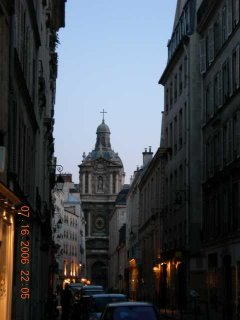




jueves, enero 12, 2006
Welcome to the Hotel Isle of Dry
Around the corner, on Dante Street, is a house I've walked past for years on my way to Café Rue de la Course. The owner frequently used to fix up his fishing boat which was parked on Zimple Street.
When I came back to New Orleans from Austin, the house and fence were more extensively spray- painted than most. It was only in the last few days that I started to figure out what it all meant.
The owner probably had either remained through the hurricane or was one of the first back in the neighborhood. He opened the Hotel Isle of Dry as a safe place for workers to stay and clean up while they went to work restoring the city.

The main entrance

Advertised features
